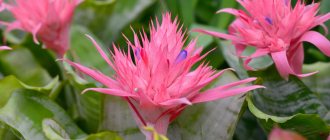Content
1 History of the campanula 2 Description of the appearance of the plant 3 Caring for the campanula 3.1 Choosing a place for a flower pot 4 Temperature conditions 5 Required humidity in the room 6 Feeding 7 Caring for the flower in the autumn-winter period 8 The process of replanting the campanula 8.1 Methods of propagating the bell 8.2 Cuttings 8.3 Seeds 8.4 Dividing bushes 9 Fighting campanula diseases 9.1 Getting rid of pests
It's nice to have flowering plants in your apartment or garden. They create a pleasant atmosphere. For beginners, you can pay attention to such a flower as campanula..
It is easy to care for and does not require any special hassle or knowledge of floriculture. Due to the shape of the flowers, it is popularly called a bell. It is generally accepted that if campanula with blue and white flowers grows in the house, it will bring family happiness and good luck.
Typical mistakes of an amateur gardener
Campanula loses its decorative effect over several years - this is a natural process. But sometimes the appearance deteriorates even in young plants. Often the grower himself is to blame for this, forgetting about caring for it or making unintentional mistakes.
Table: how Campanula reacts to grower mistakes
| What does the plant look like? | What is the reason? |
| The leaves fade, fade, or blurry translucent spots appear on them. | Sunburn. This happens especially often if you leave a sprayed plant on a southern windowsill. |
| The stems become thinner, the leaves become smaller, and the distance between them increases. | Lack of light. |
| The leaves droop and lose their tone. | Overmoistening of the soil, stagnation of water in the pan. |
| The leaf petioles and stem bases turn black. | Rot develops. The reason is regular, excessive watering combined with low room temperature. |
| No flowering or a small number of buds. | Too infrequent fertilizing or the use of inappropriate fertilizers, transplanting into a pot too “for growth”, and not pruning in a timely manner. |
| The leaves dry out and fall off. | Too infrequent watering or very dry indoor air. Or the plant is in a draft. |
Campanula leaves dry out when there is insufficient air humidity or poor watering
Sometimes the owner, who is trying to turn it into a liana, is to blame for the fact that the campanula does not bloom and withers. Reaching up the support is completely unnatural for this plant, which it clearly signals.
This material on growing browllia may also be useful:
History of the Campanula flower, photos, varieties
It is difficult to determine the exact time of its appearance. Since ancient times, this flower has been a favorite indoor plant for women. It was also planted in flower beds near the house. The hanging shoots of campanula looked harmonious on the balconies. They were grown in special pots attached to the outside of the balconies.
The plant belongs to the bellflower family. Campanula (lat. Campanula) can be either annual or perennial. It is also found in the wild, for example, in the southern part of the European continent. Many species of Campanula have been cultivated and planted as ornamentals.
The varieties used for growing in the garden are: Alba, Maya, Makrantu, Bruntwood, Superba and Akulis.
Only a few of its species are primarily planted as indoor flowers. Campanula terry and equal-leaved Campanula isophyll are commonly used. Planting and caring for this plant is accessible even to novice gardeners.
Another popular hybrid is “Kent Belle”, which is a small bush with strong branching stems 20-40 cm in height. Unlike other varieties of bells, its flowers look like stars of a dark lilac color; you can see them in the photo above. Blooms all summer.
The indoor flower campanula is also called - bride and groom . The bride is the Campanula equifolia variety Alba with white flowers, and the groom is the Mayi variety with blue flowers. They are often planted in one pot, an example is shown in the photo below. According to popular belief, this decorative flower is considered the best gift for newlyweds, which will help to acquire family happiness and maintain love in a couple.
Types of plants cultivated at home
Of the three hundred species of campanula, no more than a dozen are grown at home. Much more often, amateur flower growers purchase one of the breeding hybrids, double or large-flowered. The most popular varieties:
- Campanula equifolia (isophylla). The length of the shoots is up to 30 cm. The leaves are round in shape with a jagged edge. The diameter of the flowers is about 4 cm. Based on Campanula equifolia, hybrids Alba and Mayi were bred - the very “bride” and “groom”.
- Carpathian Campanula (carpática). The height and diameter of the bush is about 30 cm. The ovoid leaves are collected in a basal rosette. The flowers are 4–5 cm in diameter and lilac-blue. The flowering period is quite short - three summer months.
- Campanula Blauranke. Grows up to 20 cm in height. The flowers are pastel blue, 5–6 cm in diameter.
- Campanula of Pozharsky (poscharskyana). The leaves are in the shape of an almost perfect circle. The shoots are long and creeping. The flowers are small, 2–2.5 cm in diameter, bright purple. Tolerates cold and shade well.
- Portenschlagiana campanula. Height is about 15 cm. Leaves are heart-shaped, flowers are purple. Blooms from May to September. It does not lose its decorative effect even during the dormant period - old shoots dry only in the spring, when new growth has already appeared.
- Campanula garganica. The height of the plant is about 15 cm. The stems are creeping. The flowers are sky blue, about 5 cm in diameter. Blooms all summer, even in partial shade.
- Alpine Campanula (alpestris). A miniature plant no more than 5–10 cm high. The flowers are bright blue. Flowering is abundant and long lasting.
- Spoon-leaved campanula (cochleariifolia). Height - 15–20 cm. Leaves are small (3–5 cm in length). The shade of the petals varies from snow-white to bright blue.
- Campanula terry (gemina). Popular breeding hybrid. “Parents” – Carpathian Campanula and Sparrowleaf. On one plant, double flowers bloom in different shades - from snow-white to inky purple. The carved leaves are arranged very tightly, literally clinging to the stems. The plant is quite fastidious in care; it reacts to any mistakes by the grower with a lack of flowering. There is also a series of miniature hybrids - Blue Bali, White Bali, Blue Wonder, White Wonder.
Varieties of Campanula grown at home - photo
The shade of the petals of Campanula phytalis varies from white to blue depending on the growing conditions.
The Bali series of terry varieties is popular due to its miniature size
Any terry campanula looks very impressive
Alpine Campanula does not exceed 5–10 cm in height
Campanula garganica is less demanding on lighting than other varieties.
Campanula Portenschlag retains its decorative effect even during the dormant period
Campanula Pozharsky stands out with very bright flowers
Campanula Blauranka - a breeding hybrid bred on the basis of Campanula Pozharsky
Campanula Carpathiana is a rather atypical representative of the genus
Campanula Mayi is a hybrid that is often paired with the Alba variety on the windowsill or in the same pot.
Campanula Alba - a breeding hybrid nicknamed "bride"
Campanula equifolia is most often grown at home, and it is also the basis for most breeding experiments.
In addition to terry campanula, other breeding hybrids are also grown at home.
Photo gallery: achievements of breeders
Variety Napoli - large bluish-purple flowers, similar to stars
Campanula Dwarf - from a distance the flowers are very easy to confuse with lilacs
Hybrid Kronprinsesse - pastel pink bells
Campanula Loddon Anne - a very interesting and delicate pink-lilac shade of petals Spectacular variety RB Loder - pastel blue terry large (5-6 cm in diameter) bells
HybridMiss Whilmote - bright blue flowers
Variety Celestina - sky blue bells
CampanulaWhite Star - flowers of a very pure white hue
Campanula care
Have you decided to get yourself a plant like campanula?
Caring for a flower at home will not be difficult. The purchased campanula flower should be planted in a pot with a large diameter, since its roots grow quite quickly in width. Loose soil is required to ensure free growth of the root system. You can prepare a soil composition by mixing humus, leaf soil and sand in equal proportions.
Choosing a place for a flower pot
Campanula prefers a bright room. But growing in direct sunlight does not suit it. This can lead to gradual wilting, curling of the leaves and drying out.
If the plant does not receive sufficient lighting, the stems stretch and the distance between the leaves increases, which spoils the decorative appearance of the campanula.
The best option is a room with windows facing east. However, it is not recommended to place pots with plants on the windowsill. It is better to install a flower stand near the window opening. This will allow the flower to grow quickly. Soon the entire stand will be decorated with original bells.
Alternatively, you can hang a pot with campanula on the wall near the window.
With a change in the direction of the light flow, the campanula turns its open flowers towards it. It is not recommended to turn the flower in opposite directions, as this may negatively affect its flowering.
Temperature
It is necessary to protect the bells from extreme heat. In summer, you can take it out of the room. If this is not possible, then it is necessary to ensure a constant flow of fresh air. The most acceptable temperature for growing campanula is about 20-22 degrees.
In winter, it needs to be removed away from heating appliances and radiators, and also ensure that the air temperature near the flower does not rise by more than 15-20 degrees.
Required indoor humidity
Unpretentious campanula does not require a special moisture regime. It easily adapts to the usual irrigation regime. It does not require additional spraying or installation of special trays with water.
Spraying is used only in case of elevated temperatures. Abundant watering is required during the activation of growth and appearance of Campanula flowers. The soil is moistened abundantly, but the water should not stagnate.
In autumn, watering is reduced. One watering per week is enough. In winter, the plant requires even less moisture. Watering in the cold season is reduced to once a month.
If you did not have the opportunity to water the campanula in time, then do not worry. In the summer, a flower can survive without watering for up to 2 weeks. At the same time, the leaves and flowers do not dry out. But you shouldn’t experiment, as frequent breaks in moisturizing it can harm the bells.
Feeding
During the growth and flowering of campanula, you need to fertilize the soil in the pot. To do this, you can purchase fertilizers for flowering ornamental plants, for example, “Success” or “Master”. Instructions for use are included with the products. But there is no need to fertilize more often than every 2 weeks.
Transplant procedure and preparation for it
Campanula transplantation at home is rarely done. The fact is that the plant retains its decorative effect for a maximum of 2–3 years, then flowering becomes much less abundant and the shoots become bare. Therefore, it is much easier to root cuttings or grow new specimens from seeds.
Nevertheless, replanting may still be required, although the flower does not tolerate it very well. For example, it is needed if roots appear from the pot or the plant becomes sick. The best time for the procedure is early spring or mid-autumn (the period when flowering has not yet begun or has already ended). Campanula purchased in a store should be replanted as quickly as possible, a maximum of 2–3 days after purchase. The hydroponics fiber blend it is sold in is not at all suitable for growing at home. In the process, shorten the shoots by about a third, tear off all the flowers and buds.
The pot is chosen to be wide and shallow, increasing its diameter by 5–8 cm. Campanula roots quickly take over the new space. A flowerpot that is too large and voluminous is undesirable - the plant blooms profusely only if the roots tightly entwine the earthen ball.
The flower prefers soil that is light and loose, but at the same time nutritious. Such soil allows air and water to pass through well. A universal substrate for flowering indoor plants is quite suitable, but there are other options:
- leaf soil and peat chips (1:1);
- universal soil for indoor plants, peat, humus or rotted compost, coarse river sand (equal parts).
Campanula does not have any special requirements for soil - it will be quite satisfied with standard soil for flowering indoor plants
There is nothing complicated about the transplant itself:
- Fill a quarter of the new pot's volume with drainage. If the plant is very large - then a third. Cover the drainage with fresh substrate, filling the container about halfway.
- Water the plant thoroughly and remove it from the old container. If possible, try to keep the earthen ball intact.
- Using a sharp, clean knife, cut off 3–5 mm of the roots that have formed a solid “pile” at the bottom. Make several longitudinal cuts of the same depth on the sides.
- Place the campanula in a new pot and add more substrate. Lightly compact the soil. Water the plant moderately.
- Place the transplanted specimens in partial shade and keep them cool (18–20ºС). When the campanula begins to grow, return it to its original place.
Campanula is transplanted using the transshipment method
Flower care in autumn-winter
From the end of September, Campanula stops its growth phase. From this time until spring it is dormant. During this period, the plant needs moderate watering. Fertilizers are not applied in the autumn-winter season.
To preserve the decorative appearance of the bell, its elongated branches are trimmed. The lashes can be cut off, leaving only 10 cm in length.
The pot can be placed on the windowsill close to the cool glass. Such conditions are most comfortable for a campanula.
Maintaining the temperature regime and light is almost all that the campanula needs during the wintering period.
With the onset of spring days, you should water more intensively, and the flower pot should be placed in a warm place. Perhaps some branches will dry out. But don't worry - this is a normal process. Dry beds are removed.
Campanula replantation process
Like most plants, campanula is replanted in the spring. There is no need to bother her with the procedure again. This is a kind of stress for the plant. Gardeners advise replanting into a large pot only if the flower does not have enough space in the old one.
Campanula transplantation is carried out as follows:
- a layer of pebbles is poured onto the bottom of the pot to provide drainage properties;
- then a soil prepared from equal amounts of sand, humus and leaf soil is placed;
- The plant is planted in the prepared soil and watered with water.
Growing garden bellflower in open ground - video
The perennial herbaceous Campanula garden is a plant that will allow you to diversify the composition of flowers in your garden plot.
The culture impresses with its variety of varieties (up to 300 varieties) that can be used for cultivation in open ground. Taking into account the characteristics of planting and care, you can choose the best option for your area.
Methods for propagating bells
Campanula can be propagated in three ways:
• cuttings; • seeds; • dividing the bush.
Cuttings
The simplest and most frequently used method of propagating Campanula domestica is using cuttings. This type of propagation is carried out in the spring, when the young shoots have reached 10-12 cm. The cuttings are carefully broken off and placed in a container with water or in well-moistened soil with a high sand content. As a rule, planted cuttings quickly take root and do not require special care.
The main thing is that the soil in the pot does not dry out and the air temperature is within 20-25 degrees.
After 2-3 weeks, the pot with a young campanula plant can be placed on the windowsill. An increase in light will give impetus to faster development and growth of the bush.
Seeds
Reproduction using Campanula seeds is also carried out in spring. It's better if it's early spring. Since the seeds are very small, they are sown in small containers and sprinkled with a thin layer of soil. Watering the seeds is not required. It is enough to lightly spray the soil until shoots appear. Seedlings should be planted in separate pots when they grow to 10-15 cm and have 3 leaves.
Dividing bushes
The division of the garden campanula bush is carried out after the end of its flowering. The dug out bush is divided into several parts, which are planted in prepared soil. For the garden type of campanula, this process must be carried out no later than September, because the plant needs time to take root.
Common diseases and pests: what to do to save a flower
Campanula, despite its general unpretentiousness, is quite often affected by pests that are not averse to feasting on the delicate leaves. It also does not tolerate stagnant moisture in the pot at all - rot develops quickly. Competent prevention will help reduce the risk of disease and insects to a minimum:
- keeping all newly acquired plants in quarantine for a month;
- regular inspection of flowers and immediate isolation of all specimens showing suspicious symptoms;
- placing indoor plants and bouquets (especially roses and chrysanthemums) as far from each other as possible, ideally in different rooms;
- daily airing of the room, spraying the leaves, wiping off dust from them;
- following recommendations for plant care, especially regarding watering;
- using only clean pots, disinfected soil and tools;
- periodic (once every 10–12 days) replacement of irrigation water with a pale pink solution of potassium permanganate.
Table: diseases and pests affecting campanula
| Disease or pest | External manifestations | Control measures |
| Root rot | Blackening petioles of leaves and stem bases, dark brown “wetting” quickly spreading spots, a layer of mold on the ground, a distinct putrid odor. |
|
| Gray rot | “Wet” gray spots, quickly covered with fluffy “lint” with small black dots. |
For prevention, once every 3-4 months, spray the plant with a solution of Fundazol (0.1%), Topsin-M (0.3%) or Bayleton (0.05%). |
| Spider mite | Thin translucent cobwebs entwining the bases of shoots and petioles, vague pale spots on the underside of the leaf. |
|
| Shchitovka | Dark brown or gray-beige rounded bumps on the plant, rapidly increasing in volume, reddish-yellow tissue around them. |
|
| Whitefly | Small whitish butterflies that flutter from a flower at the slightest touch. |
|
| Aphid | Many small lime or black-brown insects cling to young leaves, shoot tips and buds. |
|
Photo gallery: diseases and pests that you will have to fight when growing campanula
Aphids will not disdain most indoor plants, campanula is no exception.
The whitefly, for some reason, has a particular weakness for the color yellow; this feature is used in the manufacture of homemade traps
Folk remedies against scale insects are ineffective - the pest is reliably protected by a “wax” shell
Spider mites are not insects, so they fight them using special preparations - acaricides
Often the grower himself is to blame for the development of gray rot, regularly flooding the plant.
Root rot can only be treated at an early stage of the disease.
Controlling Campanula Diseases
The main cause of disease is improperly organized irrigation regime. With abundant and frequent watering, the plant begins to rot. The disease is called gray rot. Not only the root system is affected, but also the above-ground part. The soil begins to emit a foul odor.
At the first sign of a problem in Campanula, urgent measures must be taken. If the process began recently, then the plant can still be saved. It is necessary to cut off the parts affected by the putrefactive process, and then transplant it into another pot. Watering after transplantation should be reduced.
If the foliage of the Campanula has turned yellow, the watering regime is probably broken. This happens with both a lack and an excess of moisture. If the leaves begin to curl, this will indicate poor lighting or pest infestation.
Getting rid of pests
Campanula bellflower can be affected by spider mites and scale insects. Pest control should be carried out by spraying the plant with an insecticidal agent: Fitoverm, Sunmite or Flumite. They can be purchased in specialized stores. Instructions for use are indicated on the packaging of the product.
You can try to get rid of spider mites on campanula using home methods. The humidity in the room should be increased, since this pest cannot tolerate high humidity, and then the plant is sprayed with a soap solution. It is especially important that it falls on the lower part of the leaves.
Reproduction of Campanula at home
At home, Campanula often reproduces vegetatively - by cuttings or dividing the bush. But no one forbids germinating seeds. As a rule, problems with planting material do not arise.
Cuttings
The best time for cuttings is mid-autumn. Planting material is obtained during the next pruning process. The lower part of the shoot with the rudiments of roots (the so-called heel) takes root best and fastest. It is enough to have 3-4 leaves on it.
Campanula cuttings - the lower part of the plant shoot
- Place the bases of the cuttings for 25–30 minutes in a pale pink solution of potassium permanganate or Fitosporin (5–7 ml per liter of water).
- Wait for the roots to appear by placing the planting material in water. In each container, dissolve a tablet of activated carbon and succinic acid (200 ml).
- Fill plastic cups with a mixture of peat and sand (1:1). Plant the cuttings with roots, deepening them by 2.5–3 cm.
- Create a greenhouse effect. Spray the plantings generously, not allowing the soil to dry out, and ventilate them daily. Maintain a constant temperature of 25–27ºС, provide bright, diffused light.
- After 3-4 weeks, transplant the young campanula into soil for adult plants. When they have gained about 10 cm in length, pinch the tops of the shoots for greater bushiness.
Campanula cuttings root easily and fairly quickly
Dividing the bush
The bush is divided during the transplantation process. Most often, it is not possible to untangle the roots, so the earthen lump is cut with a sharpened, disinfected knife into several approximately equal parts. The “wounds” are sprinkled with crushed chalk, colloidal sulfur, and cinnamon. The new plants are then placed in separate pots and cared for as usual. They need to be watered abundantly immediately and fertilized no later than a week later. During the first month, take special care to protect the plant from direct sunlight.
The Campanula bush is divided simultaneously with transplantation.
Germination of seeds
Seeds are sown in early spring. They retain germination for a long time, at least for a year. You need to handle them carefully - they are very small.
Campanula seeds can be easily purchased at any specialty store or grown yourself
- Fill flat containers with a mixture of leaf soil or peat chips with sand (1:1), moisten and level the substrate.
- If possible, distribute the seeds evenly over the surface of the soil. Sprinkle a little fine sand (layer 2–3 mm thick) and moisten again with a spray bottle.
- Cover the containers with glass or film. As it dries, spray the soil with a weak solution of a root formation stimulator - potassium humate, Epin, Zircon (2-3 ml per liter of water).
- Open the greenhouse daily for ventilation and wipe off any condensation that may form. Maintain the temperature around 23–25ºС, provide bottom heating and bright diffused light.
- Shoots appear within 5–7 days. When three true leaves have formed, plant the campanula in small pots or plastic cups. Be careful during the process, the seedlings are very fragile. Further care is normal.
When the right conditions are provided, Campanula seeds germinate very quickly.











